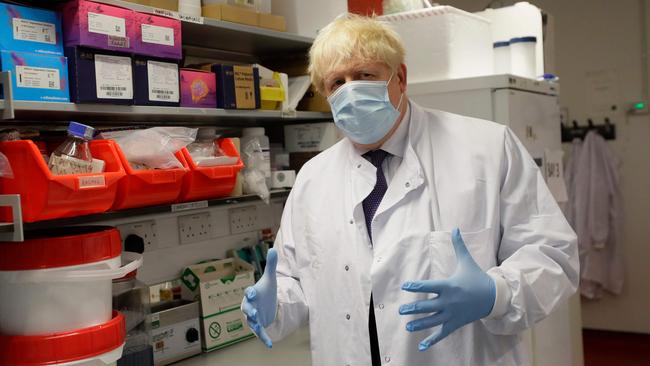Goods rebound but services lag as COVID-19 leaves global economy feeling sub-par
The global economy is operating at about 90 per cent of capacity, but some countries and industries are doing a lot better than others.

The worst day of the COVID-19 pandemic, at least from an economic perspective, was Good Friday.
On April 10 lockdowns in many countries were at their most severe, confining people to their homes and crushing activity. Global GDP that day was 20 per cent lower than it would otherwise have been.
Since then governments have lifted lockdowns. Economies have begun to recover. Analysts are pencilling in global GDP growth of 7 per cent or more in the third quarter of this year, compared with the second.
That may all sound remarkably V-shaped, but the world is still a long way from normal. Governments continue to enforce social distancing measures to keep the virus at bay. These reduce output — by allowing fewer diners in restaurants at a time, say, or banning spectators from sports arenas. People remain nervous about being infected. Economic uncertainty among both consumers and firms is near record highs — and this very probably explains companies’ reluctance to invest.
Calculations by Goldman Sachs suggest that social distancing measures continue to reduce global GDP by 7-8 per cent, roughly in line with what The Economist argued in April, when we coined the term “90 per cent economy” to describe what would happen once lockdowns began to be lifted. Yet although the global economy is operating at about nine-tenths capacity, there is a lot of variation between industries and countries. Some are doing relatively well, others dreadfully.
Take the respective performance of goods and services. Goods have bounced back fast. Global retail sales had recovered their pre-pandemic level by July, according to JPMorgan Chase. Armed with $US2 trillion ($2.74 trillion) of cash handouts from governments since the virus struck, consumers across the world have stocked up on things to make it bearable to be at home more often, from laptops to dumbbells, which partly explains why world trade has held up better than expected. Global factory output has made up nearly all the ground it lost during the lockdowns.
Services activity is a lot further below its pre-pandemic level, largely because such industries are vulnerable to people avoiding crowds. The number of diners in restaurants remains 30-40 per cent lower than normal worldwide, according to data from OpenTable, a booking platform.
The number of scheduled flights is about half what it was just before the pandemic struck.
The variation in economic performance between countries is even more striking.
The size of this year’s collapse in output means that the differences between countries’ growth rates are enormous. On September 16 the OECD, a club of mostly rich countries, issued fresh economic forecasts. Like other forecasters — such as the US Federal Reserve, which on the same day published new projections for the American economy — it has become less gloomy in recent months.
Still, the growth gap between best and worst performers in the G7 group of countries in 2020 is expected to be 6.7 percentage points, far wider than during the last global downturn a decade ago.
Of the big economies, only China is set to expand in 2020. Some countries, such as America and South Korea, face a downturn but hardly a catastrophic one. Britain, by contrast, looks to be in line for its deepest recession since 1709.
Some economists contend that the huge gap between countries is a statistical mirage, reflecting different methods of computing GDP figures. In Britain, for instance, the way statisticians tot up government spending means that school closures and cancelled hospital appointments have a bigger impact on GDP than elsewhere. But this effect is small — the bulk of the fall in output has come from the private sector.
Instead, performance comes down to three factors. The first is industrial composition. Countries such as Greece and Italy, which rely on retail and hospitality, always looked more vulnerable than, say, Germany. Its large manufacturing sector has benefited from the global goods recovery.
Second is confidence, which appears to be determined by a country’s experience under lockdown. Britain’s weak economic performance is likely to be related to the government’s poor handling of the pandemic. Britons seem more nervous than other Europeans about venturing outside.
The third factor is stimulus. America’s politicians may be unable to agree on a top-up, but they have already enacted the world’s largest rescue package, relative to the size of its economy. The OECD thinks it will be one of the better-performing rich countries this year.
What next for the 90 per cent economy? Some authorities have been forced to order further lockdowns. But others may be able to calibrate social distancing measures better without jeopardising output. That might bring the world closer to, say, a 95 per cent economy. Indeed, the OECD expects global GDP to recover further this year.
It may be tempting to think that a vaccine, if it could be rolled out widely enough, would quickly restore normality. But there will be scars. Firms’ reluctance to invest today will mean less productive capital in the future. A growing number of American workers believe they will not be returning to their old jobs.
Reallocating redundant resources towards more productive firms will take time. The Fed reckons unemployment will not return to its pre-pandemic rate of 4 per cent until 2023; analysts at Goldman Sachs think it will do so only in 2025, even though they are optimistic that a vaccine will soon be widely distributed.
Much as the disease itself has long-lasting effects, the COVID-induced downturn will leave the world economy feeling sub-par for some time to come.
The Economist



To join the conversation, please log in. Don't have an account? Register
Join the conversation, you are commenting as Logout